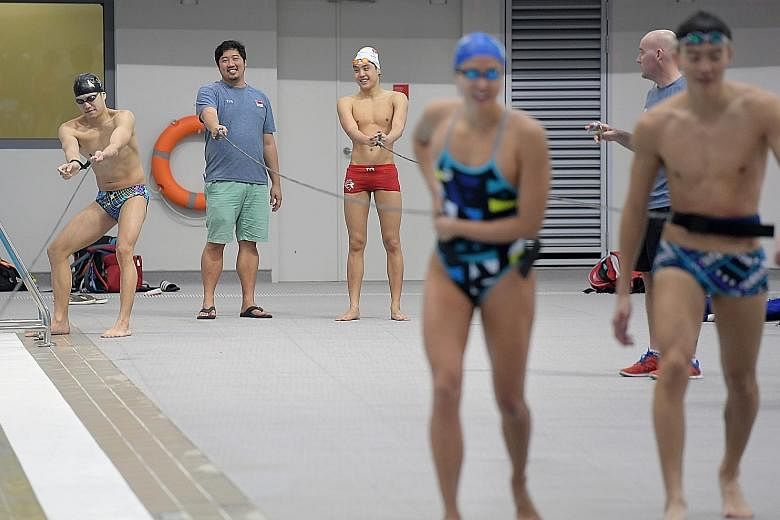The last two years have been nothing short of stunning for Singapore swimming - a record 23-gold haul at the 2015 SEA Games, followed by Singapore's first Olympic gold medal at last year's Rio Games.
And the Singapore Swimming Association (SSA) is keen to sustain the momentum that followed the gold rush by rolling out a high-performance plan to ensure the sport stays where it belongs - at the top.
Laying out the association's long-term plans yesterday, SSA president Lee Kok Choy set an ambitious target - to increase the number of national swimmers almost 10-fold to 200.
The SSA also hopes to have a relay team make the final at the Tokyo Olympics in 2020. Three Singaporeans, Joseph Schooling, Quah Zheng Wen and Quah Ting Wen competed at the Rio Games.
Lee said: "We want to build the capabilities of our swimmers. Currently, we have less than 30 of them training with the National Training Centre (NTC), but we want to have 100 to 200 of them in order to have the chance to excel at every event."
-
SSA's new high-performance plan
-
1. The appointment of a new national head coach and performance director, who will spearhead the SSA's efforts to develop the quality of swimmers and coaches in Singapore across all levels, from clubs to elite levels.
2. The introduction of a national syllabus for "learn to swim" coaching and a national proficiency testing system called the Singapore Swimming Proficiency Award (SSPA) to track and better identify talented swimmers.
3. The introduction of two programmes to provide more opportunities for the SSA to engage and support clubs to help them develop elite swimmers:
• Club excellence: Voluntary. The SSA works with clubs in specific high-performance plans for their athletes.
• Podium performance: Clubs banded according to the number of competitive swimmers on their roster. Based on that classification, they will receive grants and other benefits such as chances to attend talks by visiting technical experts.
4. A focus on building relay teams to compete at the Asian, Olympic and world-level competitions.
To that end, a new position, dubbed national head coach and performance director, will be created in the high-performance set-up.
The person, whom SSA technical director Sonya Porter and NTC head coach Gary Tan will report to, will oversee the overall development of coaches and swimmers at the clubs, enhance the quality of coaches and swimmers at all levels, and also refine the NTC's training programmes and athlete selection processes.
The candidate should be someone who has a "total view" of what is needed in a country's sporting development, as well as the experience of coaching elite swimmers at a world level.
Several foreign candidates are being considered and a decision will be made before August's SEA Games.
The Straits Times reported in January that highly regarded Australian coach Stephan Widmer is one of those in the running.
Widmer, who counts Olympic champions Libby Trickett and Leisel Jones among his proteges, was in Singapore then to conduct a series of coaching clinics.
An assistant coach to Tan will also be appointed.
The SSA also recognised that it will have to develop a close working relationship with local clubs. Two new initiatives will be launched to enhance this - the podium performance programme and the club excellence programme.
The former will band clubs into three tiers, which will determine the level of support each club gets from the SSA.
The SSA also wants to help clubs develop elite swimmers through the latter programme.
Lee said: "The club infrastructure and the scene is vibrant and they're self-sufficient. It's not that we would go into the clubs to implant a high-performance programme. But we want to collaborate more with them and support them better."
While some clubs lament that the NTC robs them of their best swimmers, thereby blunting competitiveness at club level, Lee maintains that the NTC is still the "ideal model of training for senior elite athletes".
"It is an area that will continue to have some degree of potential contention. At what point does an athlete choose to leave their coach and change a coach?
"It's a complex relationship which we have to work through. We want to support and encourage (clubs) to build their own centres of excellence in line with the NTC. We aim to replicate the rigour of NTC training at the club level."
He hopes all these measures will reduce the attrition rate of swimmers. He noted that there are high participation levels at primary school. "But when they finish secondary school, they might be looking at other interests and we do have high attrition rates then.
"The prime age for swimmers is from 20 to 24 years old. If they quit before that, they would never be able to reach the best they can be.
"We're looking at sustainability and not just one shot at glory."

